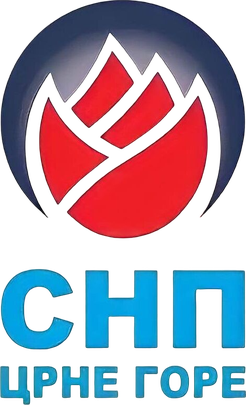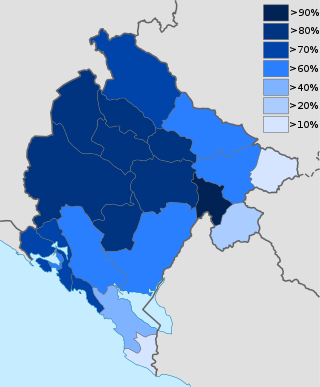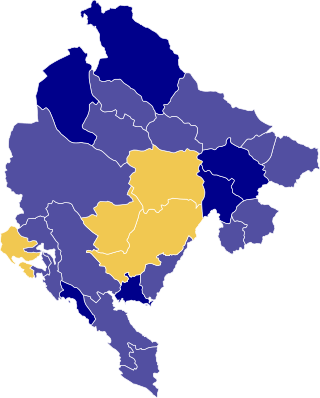
Montenegro is a country in Southeast Europe, located in the Balkans. It is bordered by Bosnia and Herzegovina to the north, Serbia to the northeast, Kosovo to the east, Albania to the southeast, and Croatia and the Adriatic Sea to the northwest with a coastline of 293.5 km. Podgorica is the country's capital and its largest city; it covers 10.4% of Montenegro's territory of 13,812 square kilometres (5,333 sq mi), and is home to roughly 31% of its total population of 621,000. Cetinje is the former royal capital and cultural centre of Montenegro and is the location of several national institutions, including the official residence of the President of Montenegro.

Svetozar Marović is a Montenegrin lawyer and politician who served as the last head of state and head of government of Serbia and Montenegro from 2003 until Montenegro's declaration of independence in 2006.
The Democratic Party of Socialists of Montenegro is a social-democratic and populist political party in Montenegro. A former long-time ruling party sitting at the opposition for the first time as of 2020, it was formed on 22 June 1991 as the successor of the League of Communists of Montenegro, which had governed Montenegro within the Socialist Federal Republic of Yugoslavia since World War II, and has remained a major force in the country ever since. The party is a member of the Socialist International and the Progressive Alliance, and an associate of the Party of European Socialists. During the 1990s, DPS was the major centre-left, social-democratic party in favour of Serbian–Montenegrin unionism. However, since 1997, the party has embraced Montenegrin independence and has been improving ties with the West, slowly turning into a catch-all party embracing Atlanticism, Montenegrin nationalism, neoliberalism, and pro-Europeanism.

The Socialist People's Party of Montenegro is a political party in Montenegro. It is a social-democratic and socially conservative party, that is positioned on the centre-left on the political spectrum with regard to economic matters. It is supportive of accession of Montenegro to the European Union, and was historically supportive of Serbian–Montenegrin unionism.

Milo Đukanović is a Montenegrin politician who served as the President of Montenegro from 2018 to 2023, previously serving in the role from 1998 to 2002. He also served as the Prime Minister of Montenegro and was the long-term president of the Democratic Party of Socialists of Montenegro, originally the Montenegrin branch of the League of Communists of Yugoslavia, which governed Montenegro alone or in a coalition from the introduction of multi-party politics in the early 1990s until its defeat in the 2020 parliamentary election. He is the longest-ruling contemporary politician in Europe, having held key positions in the country for over 33 years. However, he was defeated by the 36-year-old centrist former economy minister, Jakov Milatović, after the presidential run-off held on 2 April 2023.

Filip Vujanović is a Montenegrin politician who served as the 3rd president of the Republic of Montenegro under Serbia and Montenegro from 2003 to 2006, and the 1st president of independent Montenegro from 2006 to 2018.

Liberal Alliance of Montenegro was a Montenegrin separatist, liberal and anti-war political party, active between 1990 and 2005. The Liberal Alliance was a full member of the Liberal International from 1994 until the party's dissolution in 2005.
The European Montenegro was the ruling political alliance in Montenegro headed by Milo Đukanović's Democratic Party of Socialists (DPS).

Nebojša Medojević is a politician in Montenegro. He is the president of Movement for Changes (PzP), a political party emerging from the Montenegrin NGO Group for Changes. He ran for president in the 2008 presidential election of Montenegro.

The 1992 Montenegrin independence referendum was the first referendum regarding Montenegrin independence, held on 1 March 1992 in SR Montenegro, a constituent republic of the Socialist Federal Republic of Yugoslavia.

The current Constitution of Montenegro was ratified and adopted by the Constitutional Parliament of Montenegro on 19 October 2007 in an extraordinary session by achieving the required two-thirds supermajority of votes. It was officially proclaimed on 22 October 2007, replacing the constitution of 1992.
Constitutional Assembly elections were held in the newly-independent Republic of Montenegro on 10 September 2006. Prime Minister Milo Đukanović's Coalition for a European Montenegro won a majority in Parliament, winning 41 of the 81 seats. The opposition blocs together won 34 seats; 12 for the Serb List (SL) and 11 each for the Socialist People's Party (SNP)-led list and the Movement for Changes (PzP). Other seats were won by parties representing national minorities. As the opposition conceded defeat, DPS leader Đukanović stated "These elections showed that Montenegro is stable and firm on its European path."

Parliamentary elections were held in Montenegro on 22 April 2001. The result was a victory for the Victory is of Montenegro alliance formed by the Democratic Party of Socialists of Montenegro and the Social Democratic Party of Montenegro, which won 36 of the 77 seats.
Together for Change was a populist political alliance in Montenegro that existed from 2001 to 2006, originally known as Together for Yugoslavia. It based itself upon the necessity for a united Yugoslav state with Serbia. Predrag Bulatović was its wingleader. The pro-European semi-conservative coalition also based itself on economic and democratic reforms, bringing down of the authoritarian regime of Prime Minister Milo Đukanović and his Democratic Party of Socialists.

Presidential elections were held in Montenegro on 6 April 2008, the first after independence in 2006. The result was a victory for incumbent President Filip Vujanović, who received 52% of the vote.

Montenegrin–Serbian relations are foreign relations between Montenegro and Serbia. From 1918 until 2006, the two states were united under the Kingdom of Yugoslavia, the Socialist Federal Republic of Yugoslavia, and Serbia and Montenegro. Since 2006, there have been sporadic instances of debate on Montenegro's legitimacy as a separate state as well as much more prominent controversial debate on the Montenegrin ethnic identity. Despite this, the two countries have maintained mostly friendly geopolitical and economic relations.

Parliamentary elections were held in Montenegro on 16 October 2016. The ruling Democratic Party of Socialists (DPS) remained the largest party, winning 36 of the 81 seats, and subsequently formed a coalition government with the new Social Democrats and national minority parties. The elections were held in the midst of an alleged coup d'état attempt.

Parliamentary elections were held in Montenegro on 30 August 2020. They were the fifth parliamentary in Montenegro since gaining its independence in 2006. Eighty-one members of the Montenegrin parliament were elected. Elections were organized in special conditions, due to the COVID-19 pandemic in Montenegro. The parliamentary election was also held simultaneously with the local elections in five municipalities.

Parliamentary elections were held in Montenegro on 11 June 2023. Parliament had been dissolved by President Milo Đukanović just three days before the 2023 presidential elections were held, in which he lost to Europe Now! candidate Jakov Milatović.

Presidential elections were held in Montenegro on 19 March 2023. Long-ruling incumbent president Milo Đukanović was eligible for re-election. Since no candidate received a majority of the vote, a second round vote was held on 2 April. In the first round, Đukanović, leader of the populist DPS, received 35%, coming first. Jakov Milatović, candidate of the newly formed centrist Europe Now! movement, running on an anti-corruption platform, outperformed the polls, gaining 29% of the votes and faced Đukanović in the second round. Andrija Mandić, one of the leaders of the right-wing populist DF secured 19% of the votes, finishing third in the first round. The second round runoff resulted in Milatović defeating Milo Đukanović in a landslide, becoming the first elected president not being a member of the Đukanović's DPS since introduction of the multi-party system in 1990, winning roughly 60% of the popular vote. It was the first time a runoff vote was held since the 1997 election, making it first presidential runoff since Montenegro gained independence in 2006, also the first election since 1997 where an incumbent president actively seeking reelection was denied a second term.





















